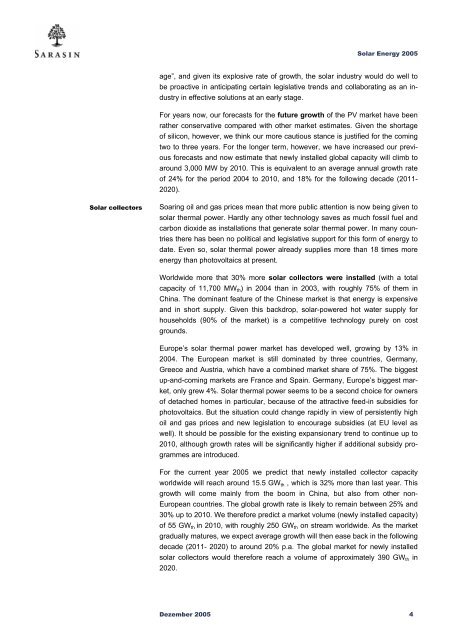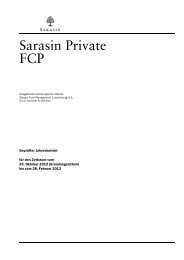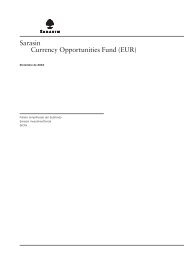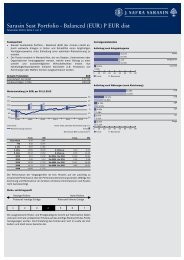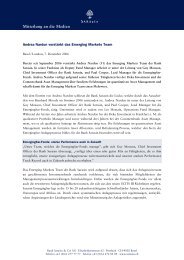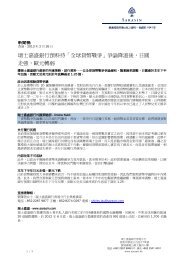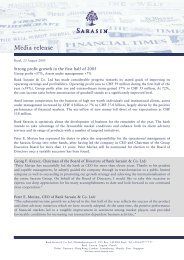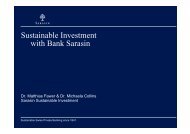Sustainability Report - Bank Sarasin-Alpen
Sustainability Report - Bank Sarasin-Alpen
Sustainability Report - Bank Sarasin-Alpen
You also want an ePaper? Increase the reach of your titles
YUMPU automatically turns print PDFs into web optimized ePapers that Google loves.
Solar Energy 2005<br />
age”, and given its explosive rate of growth, the solar industry would do well to<br />
be proactive in anticipating certain legislative trends and collaborating as an industry<br />
in effective solutions at an early stage.<br />
For years now, our forecasts for the future growth of the PV market have been<br />
rather conservative compared with other market estimates. Given the shortage<br />
of silicon, however, we think our more cautious stance is justified for the coming<br />
two to three years. For the longer term, however, we have increased our previous<br />
forecasts and now estimate that newly installed global capacity will climb to<br />
around 3,000 MW by 2010. This is equivalent to an average annual growth rate<br />
of 24% for the period 2004 to 2010, and 18% for the following decade (2011-<br />
2020).<br />
Solar collectors<br />
Soaring oil and gas prices mean that more public attention is now being given to<br />
solar thermal power. Hardly any other technology saves as much fossil fuel and<br />
carbon dioxide as installations that generate solar thermal power. In many countries<br />
there has been no political and legislative support for this form of energy to<br />
date. Even so, solar thermal power already supplies more than 18 times more<br />
energy than photovoltaics at present.<br />
Worldwide more that 30% more solar collectors were installed (with a total<br />
capacity of 11,700 MW th ) in 2004 than in 2003, with roughly 75% of them in<br />
China. The dominant feature of the Chinese market is that energy is expensive<br />
and in short supply. Given this backdrop, solar-powered hot water supply for<br />
households (90% of the market) is a competitive technology purely on cost<br />
grounds.<br />
Europe’s solar thermal power market has developed well, growing by 13% in<br />
2004. The European market is still dominated by three countries, Germany,<br />
Greece and Austria, which have a combined market share of 75%. The biggest<br />
up-and-coming markets are France and Spain. Germany, Europe’s biggest market,<br />
only grew 4%. Solar thermal power seems to be a second choice for owners<br />
of detached homes in particular, because of the attractive feed-in subsidies for<br />
photovoltaics. But the situation could change rapidly in view of persistently high<br />
oil and gas prices and new legislation to encourage subsidies (at EU level as<br />
well). It should be possible for the existing expansionary trend to continue up to<br />
2010, although growth rates will be significantly higher if additional subsidy programmes<br />
are introduced.<br />
For the current year 2005 we predict that newly installed collector capacity<br />
worldwide will reach around 15.5 GW th , which is 32% more than last year. This<br />
growth will come mainly from the boom in China, but also from other non-<br />
European countries. The global growth rate is likely to remain between 25% and<br />
30% up to 2010. We therefore predict a market volume (newly installed capacity)<br />
of 55 GW th in 2010, with roughly 250 GW th on stream worldwide. As the market<br />
gradually matures, we expect average growth will then ease back in the following<br />
decade (2011- 2020) to around 20% p.a. The global market for newly installed<br />
solar collectors would therefore reach a volume of approximately 390 GW th in<br />
2020.<br />
Dezember 2005 4


